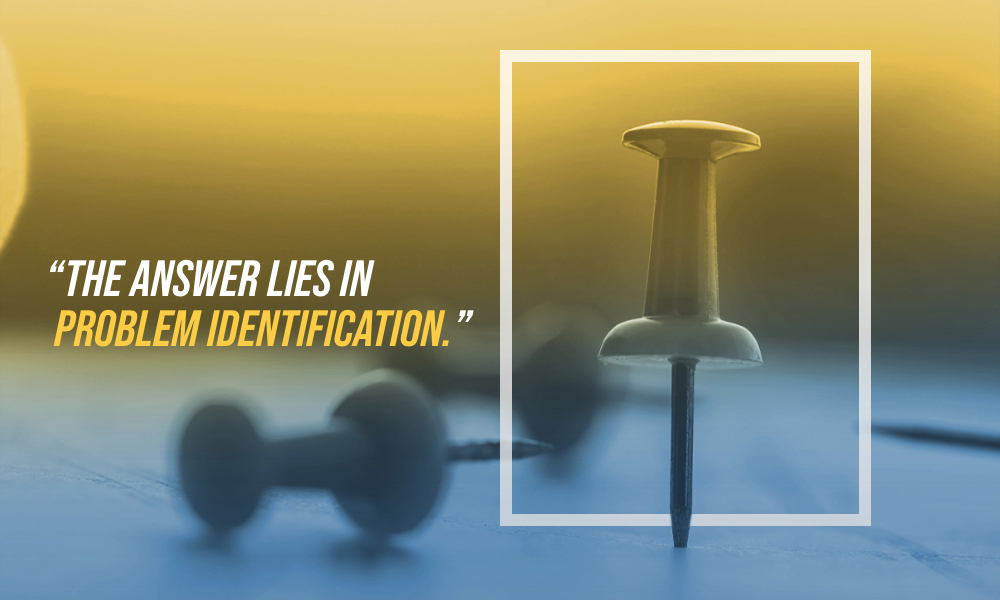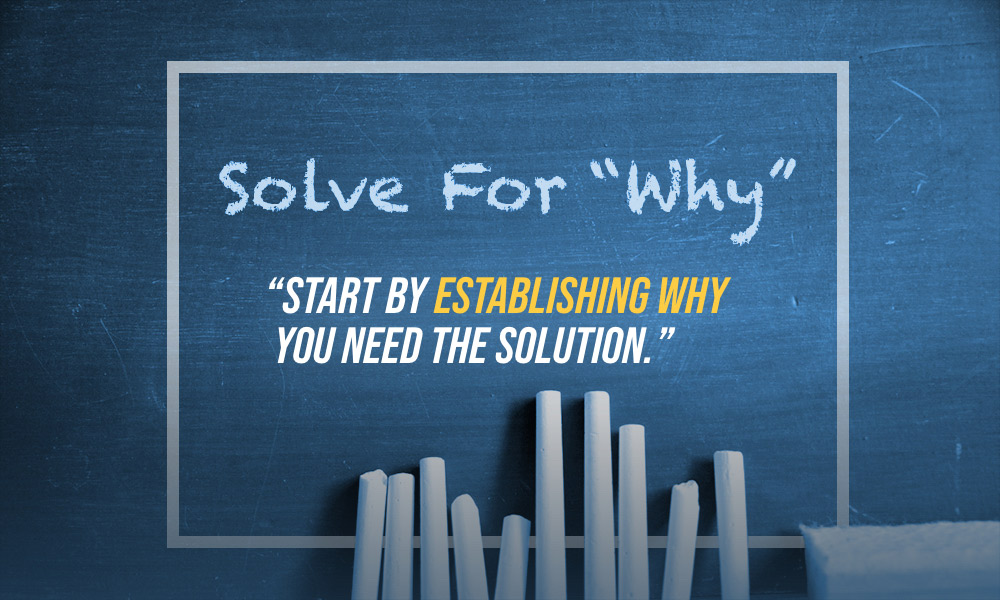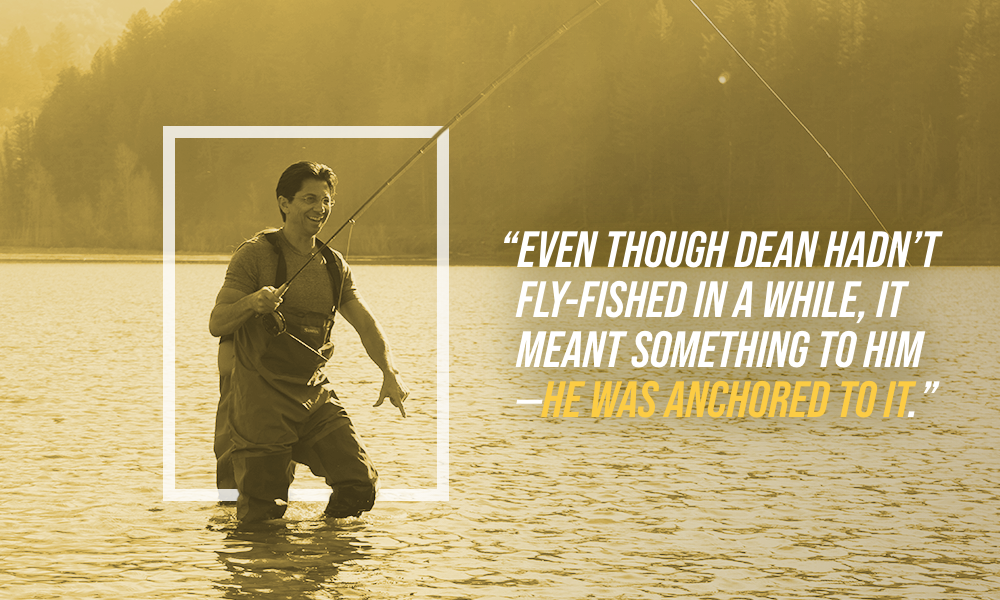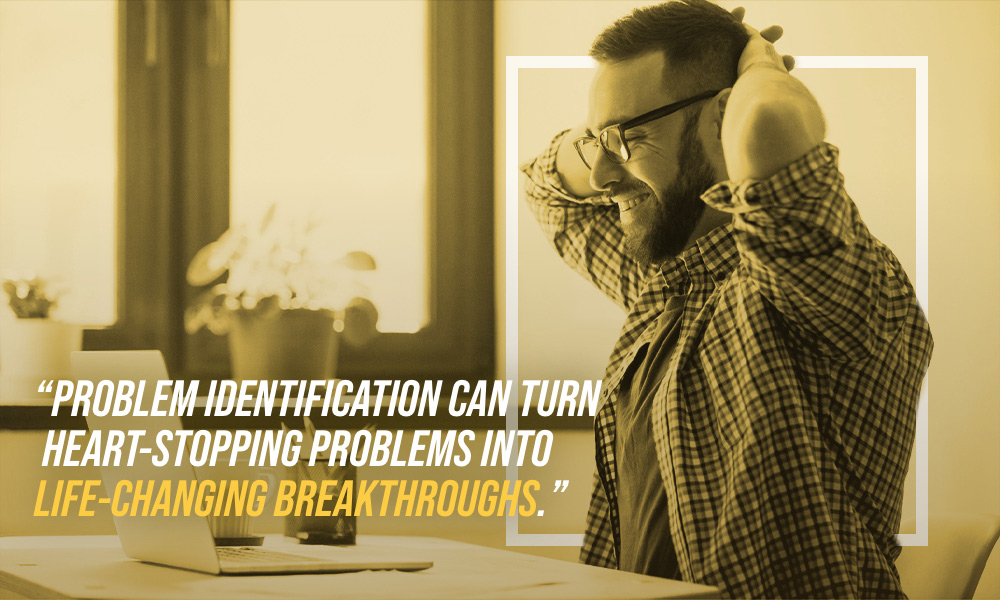Solving problems can be difficult. Mainly because most of the time, we’re not actually identifying the real problem. But problem identification can help.
Problem identification is a multi-step method that pinpoints and solves life’s difficult dilemmas. With problem identification, you identify the root cause of a problem, develop a detailed problem statement and implement an ideal solution. The problem identification process allows you to look deeply into the issues at hand. And it encourages you to create a solution that directly targets the problem at its source.

Of course, not all of life’s problems require a detailed identification process. But many times throughout your professional career and your personal life, you’ll run into issues that need some top-notch problem-solving skills.
Whether you’ve recently found yourself in a jam you can’t seem to wiggle out of, or you’re just preparing for the potential hurdles on your path, we’re here to help. Consider this 7-step problem identification process (plus a personal anecdote from Dean!) to help you solve issues effectively.
What is a Problem Identity and Why is Problem Identification Important?
Before we dive into the definition of problem identity, let’s back up a bit. Why is problem identification important in the first place? Think about it this way: How many times have you seen a commercial for a product that boasts a “breakthrough solution,” only to discover the “solution” addresses the wrong problem?
From business software to kitchen appliances, the world is full of entrepreneurs bursting with ideas. But for these ideas to be successful, they must address a clear need, solving for it at its root. And more often than not, a company won’t do its due diligence in clearly defining the problem they’re attempting to solve or even consider why those issues need to be addressed.

Ultimately, these organizations miss opportunities, waste resources and end up pursuing initiatives that address a problem’s symptoms rather than its root cause. In the words of Dean Graziosi, they ultimately go faster than ever before, but they’re on a treadmill—not a ladder. Businesses need to become better at asking the right questions, so they can tackle the right problems to create products and services that address real issues.
This is where problem identification comes in!
A “problem identity” is a simple way of defining the obstacle at hand to better understand the goal to accomplish or issue to solve. Problem identification is how you can get to the heart of the issue, learn how the issue affects yourself or others and develop an effective solution. It’s a way for you and your business to climb the ladder and get off the treadmill—for good.
The Proven 7-Step Problem-Solving Process
Of course, simple questions like picking coffee or tea in the morning don’t require expert-level problem-solving skills. But, there will be moments in life and in business when you’ll need to have a solid process for working through the obstacles standing in your way—even if you’re just having fun with friends.
Case in point: A fishing trip in the mountains Dean took with 10 close (and highly competitive) friends. What started began as a simple day of fly-fishing quickly turned into a day of problem-solving when the host of the trip announced a competition.
Teams of two would each tackle 8 individual fishing holes that were home to 6 different types of trout. The catch? Each team only had 20 minutes at each fishing hole to catch as many fish as possible.
The stakes were high: Points were given for each type of trout caught AND the size of the trout. Plus, the winner had bragging rights for the entire rest of the trip. Once Dean was paired with his partner, he knew it was go-time.
To win the competition, it was going to take some serious problem-solving.
Learn the ropes of what it takes to solve real-word problems with this 7-step problem-solving process, plus discover how Dean used problem-solving for the ultimate fishing trip bragging rights in the article below!
Step 1: Establish the Need for the Solution
Problem-solving can be frustrating—especially if you’ve spent days on end brainstorming possible solutions. But before brainstorming solutions, you need to zoom all the way out and uncover the real problem. Problem identification requires that you look at the big picture first.
So, start by establishing why you need the solution. What is the basic need that must be addressed?
Here are some possible big-picture needs:
- Finances or monetary gain for supporting your family
- Logistics to keep your business or career moving
- Peace of mind to ease troubled nerves or pent-up anger
- Professional kudos for introducing new solutions to your industry
- Individual growth to boost your skills or professional development
After deciding on the basic need, ask yourself who stands to benefit from the solution. If not you, then who? Is it your family, your colleagues, your students or a third party?
Then, picture your desired outcome. Will you be earning more money, elevating your family life or growing your business?
Think about why all of this matters to you. Like Dean says, “When you focus on the outcome rather than the obstacle, your life will never be the same.”
Sometimes, you realize that you’ve poured so much effort into finding a solution that you’ve lost sight of the real problem. By establishing the need that must be solved, you can keep track of your priorities. In Dean’s case, his priority in this situation was to win the competition.
Step 2: Confirm the Need Aligns with Your Core Values
Once you’ve established the need for a solution, ask yourself if the need falls in line with your core values. Your core values are your main principles in life. They’re the beliefs and qualities you use to navigate your personal and professional worlds.
Some common core values include:
- Authenticity
- Balance
- Compassion
- Creativity
- Growth
- Honesty
- Justice
- Loyalty
- Responsibility
Before moving forward with the problem-identification process, make sure that your reasoning for solving the problem matches your core values. The purpose of this step is to justify that the problem is worth your energy and attention, and that solving it would fit your character.
For Dean on his fishing trip, his desire to win was fueled by his core values. Dean’s grandfather, who was like a second dad to him, loved fishing and taught Dean to fly-fish as a child. Even though Dean hadn’t fly-fished in a while, it meant something to him—he was anchored to it. That desire to make his grandfather proud by flexing his fly-fishing skills pushed Dean to problem-solve his way to win.

For yourself, consider all of the desired benefits for solving your problem. Will the solution amplify your long-term goals? Does it feed into your purpose in life or the people you love, like Dean’s admiration for his grandfather? If the answer is yes, go ahead and move along to Step 3.
Step 3: Add Context to the Problem Analysis
At Step 1, we started with the big picture. Now, it’s time to dive into the problem’s details. Think of this step as setting the stage for the potential solution. The problem’s details can lend a hand in creating the criteria your solution must meet.
Whether it’s your 1st, 4th or 400th time returning to the problem, ask yourself:
- What possible solutions have you tried?
- What solutions have others tried?
- Are there any limitations to implementing a potential solution?
This is a great time to loop family, friends or colleagues into your problem analysis. You can combine your different thinking styles to create a list of details that could help shape a possible solution. For Dean standing riverside, this was a time to investigate how his other competitors were doing.
At fishing hole 1, no trout were biting—none, zero, zilch. So, he started analyzing the details of the situation. By fishing hole 2, Dean noticed that trout could see him approaching through the crystal clear water. By fishing hole 3, he realized that if he hid or crawled up to the fishing hole to avoid the trout from seeing him, he can catch better fish.
Suddenly, fish were biting for Dean and not his other friends! As Dean was catching fish left and right, his friends were continuing to cast their lines as hard as possible, not understanding what was going wrong. Instead of problem-solving, they were running harder on the treadmill rather than joining Dean on the ladder.
That’s when Dean moved along to the next fishing hole and the next step of the problem-solving process.
Remember: You don’t have to have an answer to your problem just yet! The goal with Step 3 is to add context to the issue so you can construct a specific problem statement.

Step 4: Brainstorm a Problem Statement
Ready for the fun part? Let’s create a problem statement! A problem statement is a short and sweet description of the issue that needs solving. Your statement should clearly outline the gap between the current state of the problem and how you’d ideally like the problem to be solved.
A problem statement uses the famous 5 W’s:
- Who
- What
- When
- Where
- Why
Ideally, your problem statement should tell you what the issue is, why it’s an issue and why it’s necessary to solve it.
Use all of the previous steps to construct your problem statement. For instance, the “who” in your statement can be the person who will benefit from the solution. The “why” can be the basic need or your core values that support the need.
It’s important for you to set the scene with a problem statement, the same way that Dean did on his fishing trip. Right at the start, he identified the problem and how his core values motivate him. He also realized that each of his competitors were equal to him: Every friend had the same fly rods, the same flies and the same fishing hole. So, he set forward with a way to brainstorm the best solution—just like you can!
Step 5: Brainstorm the Best Solution for the Specific Problem
The last step was a little fun, but this one is a lot of fun! In Step 5 of the problem identification process, you finally brainstorm the best solution for your specific problem.
There is only one rule in brainstorming: Don’t dismiss any ideas! With your detailed problem statement in mind, ask yourself what potential solutions would solve the issue. Then, write down every possible solution that comes to mind, without judgment.
Next, clearly outline the requirements that your solution must meet. Think about all the details it must solve for, and consider if there are any constraints on resources (time, money, people, etc.). Once you have your criteria, identify any fellow problem-solvers or stakeholders you should involve in the decision-making process.
Do they have any additional requirements the solution must meet? Can they think of any possible solutions? Bring them in to get their point of view, and record all the potential solutions they provide.
Now that you have a master list of possible solutions, it’s time to find the best one. Run each possibility through your criteria. Then, run it through the previous steps: Does the solution match the need? Does it align with your core values and what you stand for? Has anyone tried to implement this solution and failed?
For Dean, he combined his previous tactics of crawling up to the fishing hole with a new method he learned: Landing his bait right where the water in the river is churning to catch the attention of fish. He learned—just like you will—that after careful analysis, one solution reigns supreme.
Step 6: Implement the Right Solution to the Right Problem
You’ve almost reached the finish line! Once you’ve identified the most suitable solution, identify the necessary steps to implement it. Keep in mind that you don’t need to take this step alone. Tap in any fellow problem-solvers or stakeholders who can help put the plan in motion.
Think about how Dean finished out his competition: By the time he reached the second-to-last hole, he was combining all of the details he’d learned from his problem analysis to create the best possible solution. So much in fact, that he caught 13 fish in the last fishing hole alone!
So, follow suit with Dean and once you’ve made a plan for implementation, roll out the solution! Be sure to consider how you will evaluate your solution. How will you measure success? If you’re unsure, go back through the steps in the problem-identification process to remind yourself of what you’re trying to achieve.
Step 7: Create a Problem-Solving Case Study or Feedback Loop
Once you implement your solution, create a way to evaluate the impacts of your decision-making. Design your own case study or feedback loop, weighing what you thought the results would be vs. what really happened.
Ask yourself the same questions Dean asked himself, like “What did I do that worked?” Whatever worked, do more of it. Then ask yourself, “What did I do that didn’t work?” Change those things or throw them out entirely.
Next, create a flowchart of your methodology for future reference. Start documenting what’s working and magnify it. Realize what moves the needle and what makes an impact, and do more of that.
Feel free to share this resource with peers and students. That way, the next time a major problem comes your way, you can return to this process to find a clear path.
Problem Identification: Turning Major Problems into Breakthroughs

There’s nothing worse than getting sidetracked by a major roadblock—or in Dean’s case, losing to a group of amazing but ultra-competitive friends. Fortunately, this 7-step process of problem identification can turn heart-stopping problems into life-changing breakthroughs. When you take the time to better organize the issue, you can turn complex problems into actionable solutions, just like Dean.
Will you use this 7-step process to overcome a hurdle in your life?






One Response